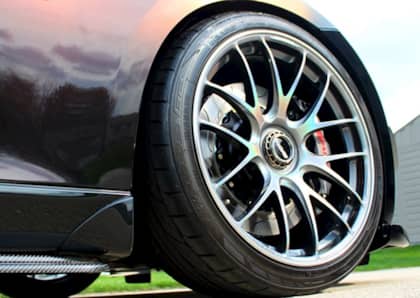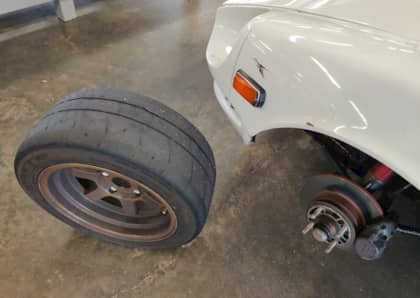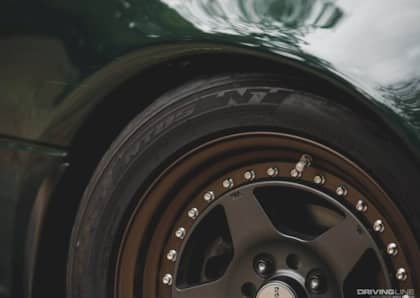The 3 Best Bang-for-the-Buck Performance Mods You Can Make for Your Car
In a perfect world, we'd all have an unlimited tuning budget. In reality, many of the decisions made about which performance parts to install on our cars are budget-related, asking us to try to squeeze the best bang for the buck out of the cash we've allocated for our rides.
Fortunately, with a little planning and some careful shopping, it's relatively easy to make dramatic improvements to your vehicle's capabilities without spending major money. Here are our recommendations for the three areas to upgrade first when trying getting the most performance out of your aftermarket upgrades.
1. Handling Upgrade: Ultra High Performance Summer Tires
Tires are the single most cost-effective improvement you can make to almost any vehicle. A big part of this has to do with their versatility. A larger, stickier contact patch will not only help your vehicle grip the pavement better while cornering, but it will also improve traction from a launch (boosting acceleration) as well as help you stop more quickly by digging its claws that much deeper into the pavement.
There are two main points to consider when evaluating a new set of tires. The first is sizing. Using the Plus Sizing rule, it's usually possible to maintain roughly the same overall diameter of your current wheel and tire setup while moving to a wider footprint.

For example, if you have a 17-inch wheel with a 215 mm wide tire and an aspect ratio of 45 (215/45R17), you can move to an 18-inch wheel with a 225 mm wide tire with an aspect ratio of 40 (225/40R18) without having to worry about clearance or affecting your speedometer. This is considered a Plus One Size upgrade. If you're running a stock suspension setup, this can be an important consideration.
The second decision to make is what type of rubber compound best meets your driving needs. Most manufacturers typically offer a stickiness ladder of compounds starting at a street tire and moving all the way up to a dedicated track tire.
For everyday driving with spirited canyon carving thrown into the mix, a Summer Ultra High Performance tire is typically a good option. For example, a manufacturer like Nitto offers the NT555 G2, with a rain-ready tread pattern and a treadwear rating of 300 for this purpose. If your vehicle is going to be entering into autocross competition, a more aggressive compound like the NT05 with a 200 treadwear and a larger center rib is more appropriate. Higher treadwear tires with more rain channeling are better all-around performers that will last longer outside of a race track.

Track tires that are street legal but truly intended for competition driving due to their low treadwear (and higher stickiness) rating of 100 combined with larger, continuous treadblocks, include the NT01 (road course) and NT05R (drag radial). The lower the treadwear, the more quickly a compound will wear out with regular driving and heat-cycling. The flip-side, of course, is greatly improved traction on dry pavement and more resiliency in a track environment.
2. Acceleration Upgrade: ECU Tuning
Most modern cars have had their engines tuned from the factory to walk a fine line between producing power, reducing fuel consumption and tailpipe emissions, and maximizing longevity. There's typically a fair amount of overhead in the first department for squeezing out extra output as long as you don't mind the additional fuel cost that comes with it. Further good news? Most tunes don't have to come anywhere near impacting the reliability, street manners or lifespan of your motor.

There's more than one way to approach basic ECU tuning. You can flash your existing engine controller with an aftermarket tune, either at a shop or DIY with a tool that you purchase for communicating directly with your car's ECU. You can often also purchase a pre-tuned chip that takes into account your current setup (whether it's stock or features any extra mods you might have done like exhaust or intake), or send an older vehicle's ECU away to be programmed by a third party. Finally, you can head to a shop and have them put your vehicle on a dyno, producing a more expensive but completely custom tune.
Turbocharged and supercharged cars see the biggest boost in power from ECU tuning, but even a naturally-aspirated engine will unlock a few ponies with more aggressive management settings.
3. Braking Upgrade: More Aggressive Pads
Similar to factory ECU tuning, the brake pads that came with your car are intended to last as long as possible while generating minimal dust and noise, all while still providing safe levels of stopping power. The less you care about dust and noise, the more "whoa" you can add to your existing braking setup through a simple pad swap.
Dirtier rims and a bit of squeal aren't the only considerations you'll need to make when choosing an aftermarket brake pad, however. Again, the type of driving you do will have the most input on your decision.

Ultra-aggressive track pads use compounds that aren't suitable for street use. They are designed to provide excellent initial bite and thermal management, but only when warmed up to competition temperatures. In regular driving, they will never get enough heat into them to provide a safe level of stopping power and can actually reduce the performance of your braking system. Install these pads once you're in the pit, not before you make it trackside.
With that said, there are a number of brake pads out there that balance bite and fade with an operating profile more suitable to street temperatures. If you're going to be driving your car on a road course every once in a while, but also want extra stopping power on the street, this is the type of pad you should look for. Just be aware of the need to clean your rims more regularly and replace your pads more quickly, and brace yourself for the occasional school bus squeal when coasting down to a stop. They also won't last as long as most gentler factory pads, and they may accelerate wear on your rotors.











